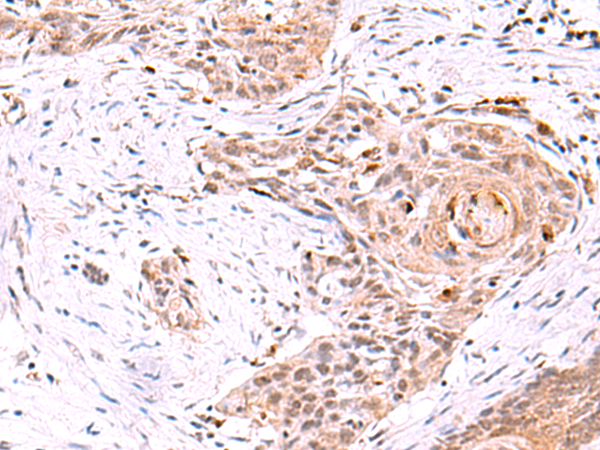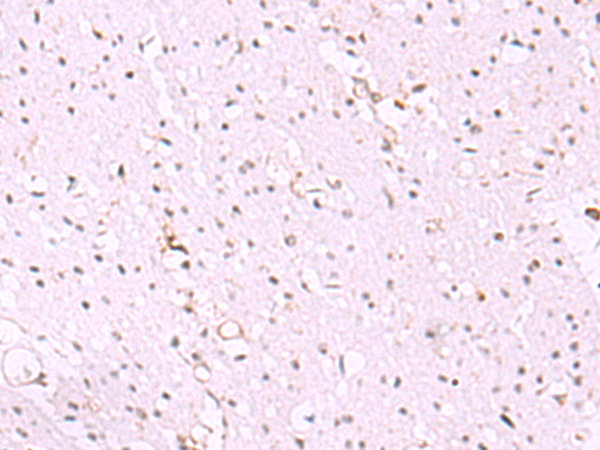

| WB | 咨询技术 | Human,Mouse,Rat |
| IF | 咨询技术 | Human,Mouse,Rat |
| IHC | 1/25-1/100 | Human,Mouse,Rat |
| ICC | 技术咨询 | Human,Mouse,Rat |
| FCM | 咨询技术 | Human,Mouse,Rat |
| Elisa | 1/5000-1/10000 | Human,Mouse,Rat |
| Aliases | TCF; HNF4; MODY; FRTS4; MODY1; NR2A1; TCF14; HNF4a7; HNF4a8; HNF4a9; NR2A21; HNF4alpha |
| Host/Isotype | Rabbit IgG |
| Antibody Type | Primary antibody |
| Storage | Store at 4°C short term. Aliquot and store at -20°C long term. Avoid freeze/thaw cycles. |
| Species Reactivity | Human, Mouse, Rat |
| Immunogen | Synthetic peptide of human HNF4A |
| Formulation | Purified antibody in PBS with 0.05% sodium azide and 50% glycerol. |
+ +
以下是关于HNF4A抗体的3篇参考文献概览:
1. **文献名称**:*Hepatocyte Nuclear Factor 4 Alpha (HNF4A) Downregulation in Hepatocellular Carcinoma: Implications for Prognosis*
**作者**:Tanaka et al.
**摘要**:该研究通过免疫组化分析肝癌组织中HNF4A蛋白表达,发现其表达水平与患者生存率显著相关,提示HNF4A可作为肝癌预后标志物。
2. **文献名称**:*Role of HNF4A in Pancreatic β-Cell Function: Insights from Antibody-Based Knockdown Models*
**作者**:Guo et al.
**摘要**:利用HNF4A特异性抗体进行免疫荧光及Western blot实验,证实HNF4A缺失导致β细胞胰岛素分泌功能受损,关联2型糖尿病发病机制。
3. **文献名称**:*ChIP-Seq Analysis of HNF4A Binding Sites Using Monoclonal Antibodies Reveals Novel Gene Regulatory Networks*
**作者**:Johnson et al.
**摘要**:通过HNF4A抗体染色质免疫沉淀(ChIP)结合测序技术,鉴定出肝脏发育中HNF4A调控的多个新靶基因,拓展对其转录调控网络的理解。
---
如需更多文献或领域细分(如抗体技术开发),可补充说明进一步筛选。
The hepatocyte nuclear factor 4 alpha (HNF4A) is a transcription factor critical for regulating gene networks involved in embryonic development, metabolism, and cellular differentiation, particularly in the liver, pancreas, and kidneys. As a member of the nuclear receptor superfamily, HNF4A binds DNA as a homodimer and interacts with coactivators to modulate tissue-specific gene expression. HNF4A antibodies are essential tools for studying its role in development, metabolic disorders, and diseases like maturity-onset diabetes of the young (MODY1) and certain cancers.
These antibodies are commonly used in techniques such as chromatin immunoprecipitation (ChIP), Western blotting, and immunofluorescence to map HNF4A binding sites, quantify protein levels, and assess subcellular localization. Researchers also employ HNF4A antibodies to investigate its isoforms (HNF4A1 and HNF4A2), which arise from alternative promoter usage and exhibit distinct tissue distributions. Specificity validation is crucial, as cross-reactivity with related nuclear receptors or isoforms can confound results.
HNF4A dysfunction is linked to metabolic syndromes, pancreatic β-cell impairment, and epithelial-to-mesenchymal transition in cancer. Antibodies targeting post-translational modifications (e.g., phosphorylation, acetylation) help dissect regulatory mechanisms affecting HNF4A stability and activity. In clinical research, these antibodies aid in characterizing mutations in HNF4A-associated diseases and evaluating therapeutic strategies aiming to restore its transcriptional activity.
×